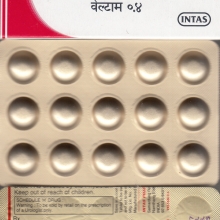Home / Categories / VELTAM-0.4MG

VELTAM-0.4MG
(15X10'S)
TAMSULOSIN-0.4MG
DRUG FOR BENIGN PROSTATE HYPERTROPHY(BPH)
INTAS PHARMACEUTICAL-XENITH DIVISION
Product Details
Tamsulosin is a selective antagonist at alpha-1A and alpha-1B-adrenoceptors in the prostate, prostatic capsule, prostatic urethra, and bladder neck. At least three discrete alpha1-adrenoceptor subtypes have been identified: alpha-1A, alpha-1B and alpha-1D; their distribution differs between human organs and tissue. Approximately 70% of the alpha1-receptors in human prostate are of the alpha-1A subtype. Blockage of these receptors causes relaxation of smooth muscles in the bladder neck and prostate.
Indication
Used in the treatment of signs and symptoms of benign prostatic hyperplasia (reduction in urinary obstruction and relief of associated manifestations such as hesitancy, terminal dribbling of urine, interrupted or weak stream...etc.)
Associated Conditions
- Benign Prostatic Hyperplasia (BPH)
- Benign Prostatic Hypertrophy (BPH)
- Bladder Outlet Obstruction
- Ureteral Calculus
Pharmacodynamics
Tamsulosin, a sulfamoylphenethylamine-derivative alpha-adrenoceptor blocker with enhanced specificity for the alpha-adrenoceptors of the prostate, is commonly used to treat benign prostatic hyperplasia (BPH). The drug is commercially available in a racemic mixture of 2 isomers, and is pharmacologically related to doxazocin, prazosin, and terazosin. However, unlike these drugs, tamsulosin has a higher affinity for the alpha-1A- adrenergic receptors, which are located in vascular smooth muscle. Studies show that tamsulosin has about 12 times greater affinity for alpha-1 adrenergic receptors in the prostate than those in the aorta, which may result in a reduced incidence of adverse cardiovascular effects.
Mechanism of action
Tamsulosin is a selective antagonist at alpha-1A and alpha-1B-adrenoceptors in the prostate, prostatic capsule, prostatic urethra, and bladder neck. At least three discrete alpha1-adrenoceptor subtypes have been identified: alpha-1A, alpha-1B and alpha-1D; their distribution differs between human organs and tissue. Approximately 70% of the alpha1-receptors in human prostate are of the alpha-1A subtype. Blockage of these receptors causes relaxation of smooth muscles in the bladder neck and prostate, and thus decreases urinary outflow resistance in men.
Absorption
Absorption of tamsulosin HCI from capsules 0.4 mg is essentially complete (>90%) following oral administration under fasting conditions.
Volume of distribution
- 16 L [intravenous administration to ten healthy male adults]
Protein binding
94%-99%
Metabolism
Tamsulosin HCI is extensively metabolized by cytochrome P450 enzymes in the liver, however, the pharmacokinetic profile of the metabolites in humans has not been established.
Route of elimination
Tamsulosin hydrochloride is extensively metabolized by cytochrome P450 enzymes in the liver and less than 10% of the dose is excreted in urine unchanged. The metabolites of tamsulosin hydrochloride undergo extensive conjugation to glucuronide or sulfate prior to renal excretion. On administration of the radiolabeled dose of tamsulosin hydrochloride to four healthy volunteers, 97% of the administered radioactivity was recovered, with urine (76%) representing the primary route of excretion compared to feces (21%) over 168 hours.
Half life
5-7 hours
Clearance
- 2.88 L/h
Toxicity
LD50 = 650 mg/kg (in rats)
Affected organisms
- Humans and other mammals
SOURCE:DRUGBANK
Substitutes
